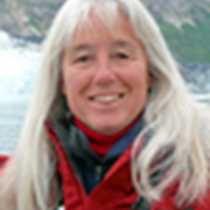Saginaw Bay/Frederick Sound, Southeast Alaska
Charismatic megafauna captured our attention today. We were “barely” awake when we explored the narrow finger called Eliza Harbor, which juts into the southern end of Admiralty Island. This large island has perhaps the densest population of brown (grizzly) bears anywhere. We were advised to stay quiet when we emerged from our cabins so as to not scare any wildlife that might not be used to our alien sounds. Even so, upon entering the bay, we spotted a bear that quickly ducked back into the bush when we approached. Later, another was seen at a great distance feeding high up in a meadow above treeline. Yet we knew that it was a very large animal. We also had a silent but conspicuous display on deck from the “Bear Bottom Brigade.”
We spent time in the later morning touring by kayak and Zodiac in Halleck Harbor in Saginaw Bay on the island of Kuiu. The limestone cliffs here yield fossils from the Permian Period and currently support interesting flora. An ancient pictograph painted at the entrance to the harbor challenged our imaginations but its original meaning remains a mystery.
There may be some question as to the charisma of seaweed, but we can still use the prefix “mega” when it comes to bull kelp. This giant brown alga forms forests in the colder waters of the subtidal zone of the Pacific Northwest. It is the productive equivalent of coral reefs, which thrive in warmer waters. It harbors and feeds a multitude of organisms. Kelp derivatives are found in products that we use every day, and people of yore and present use it to add nutrition to their diets.
The regal bald eagles of Southeast Alaska demand respect and recognition. Sitting proudly atop a spruce, their keen vision helps them find fish and other food while minimizing energy spent. Abundant resources support a high density of nesting eagles that were once endangered in other parts of the country. Despite a bounty on the birds in Alaska that existed into the 1950s, there have always been a lot of eagles in this rich land.
We stood in awed disbelief throughout the afternoon as we watched the performance of members of the AG pod of resident killer whales (orcas), and later, endangered humpbacks feeding, breaching, tail-slapping, and cavorting. They kept us occupied for hours – circling the decks, as they surrounded us. Both fish-eaters, the killer whales are taking advantage of the salmon that are approaching the mouths of their natal streams. The humpbacks feed on tons of smaller schooling fish and krill in preparation for their long migration down to Hawaii later in the year. We saw many aspects of the food web today.
As we cruised northward toward Glacier Bay, we thought the beautiful rainbow at the end of our evening would complete this remarkable day, but a few minutes later more killer whales in Chatham Strait brought us temporarily to a stop for a grand finale.




